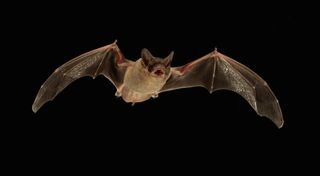Bats Use Signal Jamming to Ward Off Competitors

Just like Navy engineers who jam the sonar of enemy ships, bats can jam the signals of other bats to ward off competition for food, a new study finds.
Bats hunt by echolocation, which means they emit high-pitched sounds and listen to the echoes that bounce off their prey. But competition for food can be fierce, and Mexican free-tailed bats emit a special call that can interfere with the sonar of other bats that are pursuing a meal.
"They get into amazing aerial dogfights," said study leader William Conner, a biologist at Wake Forest University in Winston-Salem, North Carolina. "One will jam the other, and the other will jam back." [See video of bats emitting jamming signals]
Conner and his colleague Aaron Corcoran, now a post doctoral researcher at the University of Maryland in College Park, studied Mexican free-tailed bats (Tadarida brasiliensis) using high-speed infrared cameras and microphone arrays. Corcoran was examining the interaction between the bats and their prey, moths, when he noticed the bats produced a strange sound, which they only made when another bat was homing in on the moth.
"It sweeps through the frequency range that bats use, and that’s the standard method used to jam sonar and radar," Conner told Live Science. It's called "sweep jamming," he said.
Jamming the enemy
In the new study, Conner and Corcoran set up audio and video systems to watch as wild bats hunted Tiger moths. Using a speaker, the researchers played recordings of the jamming signals or other sounds, such as pure tones or white noise.
Sign up for the Live Science daily newsletter now
Get the world’s most fascinating discoveries delivered straight to your inbox.
When a bat is right about to nab its prey, it emits a "terminal buzz" that is thought to help it lock on to its meal's location. The scientists played the jamming signals both during the terminal buzz and also at other times during the hunt.
Bats that heard the jamming signal right when they were about to reach a moth meal were 86 percent more likely to miss, Conner said. This finding supports the idea that the sounds the bats made were indeed jamming signals.
The researchers ruled out a few other explanations for the sound, such as a way for a bat to defend its food patch, a method for bats to hunt cooperatively or a means of startling another bat. They watched what the first bat did immediately after it made the sweeping sound, and saw that it immediately turned back to the last known position of the moth, which suggests the signal wasn't any of the other possibilities, Conner said.
"They have evolved a signal that is very much like the signal that [engineers] use to jam sonar and radar, but they did it 65 million years earlier," Conner said.
Not just bats?
The next step is to figure out the mechanism by which the jamming signal interferes with the networks of neurons involved with echolocation. To find out, scientists would have to record the signals from the bats' brains while they're listening to the jamming sound.
In a previous study, Conner and his colleagues found that Tiger moths also emit sounds that jam the bats' signals. The moths aren't capable of producing a sweeping sound like the bats do, but they can make a clicking sound that interferes with the bats' hunting attempts.
Other species, such as antbirds, also use signal jamming to interfere with messages from a flirtatious male, according to a study published in 2009 in the journal Current Biology. Perhaps other animals that use echolocation, such as dolphins and toothed whales, also use similar jamming techniques, the researchers said.
"We're just starting to look," Conner said.
Follow Tanya Lewis on Twitter and Google+. Follow us @livescience, Facebook & Google+. Original article on Live Science.

Most Popular


